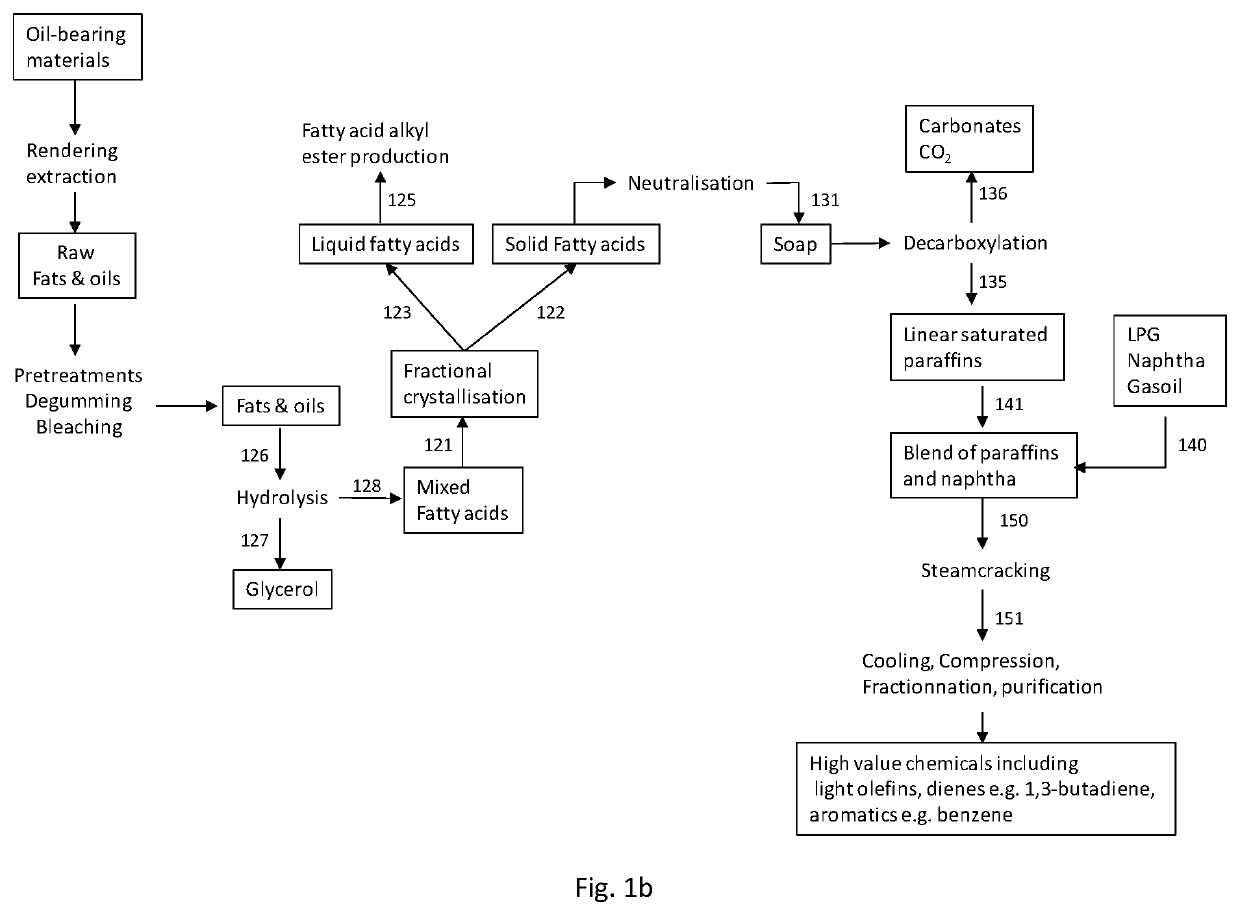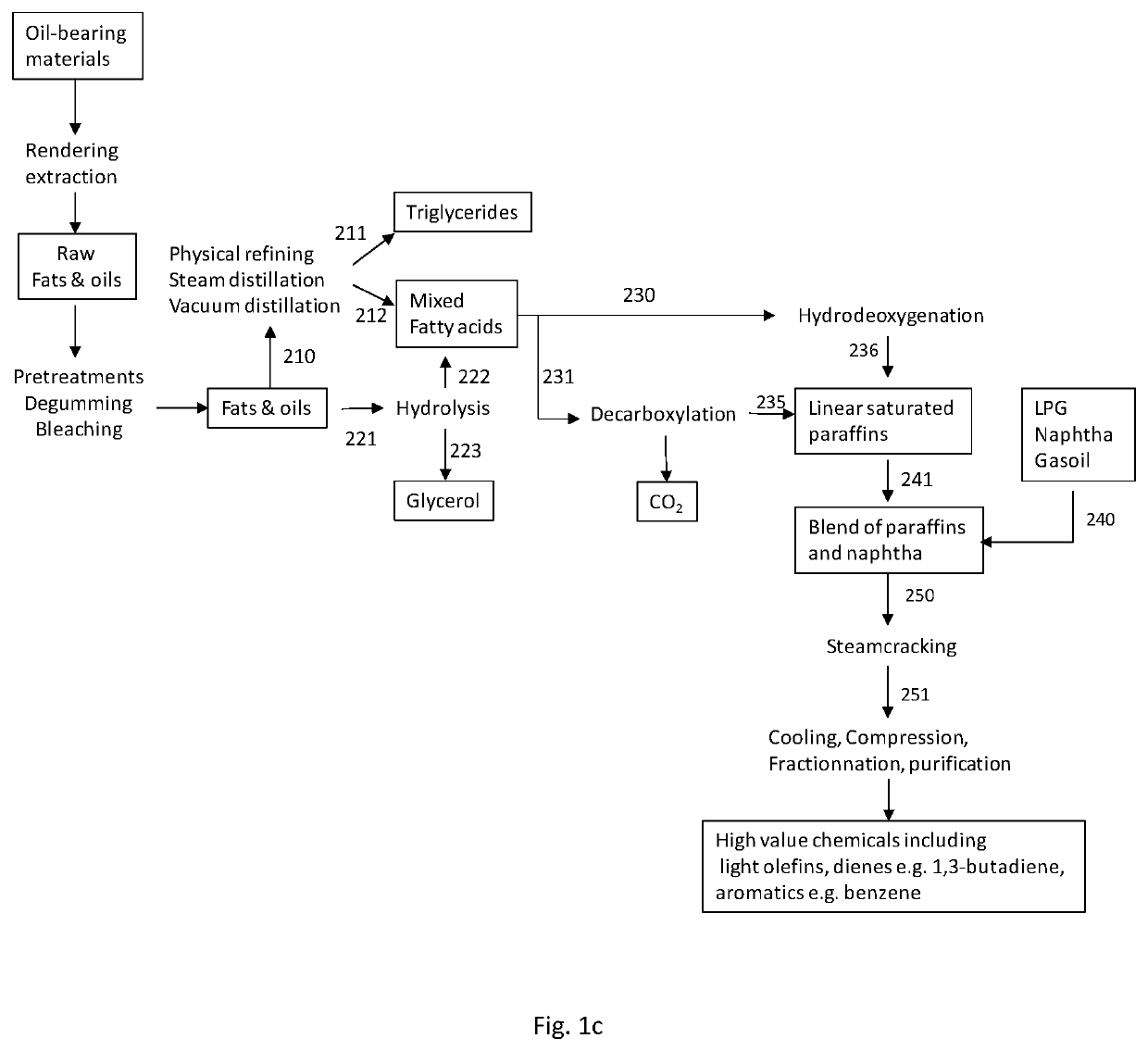Process for the production of high value chemicals from biologically produced materials
a biologically produced material and high-value technology, applied in the direction of bulk chemical production, hydrocarbon oil treatment products, thermal non-catalytic cracking, etc., can solve the problems of gasoil that cannot be steam cracked without naphtha cracker, fouling and coking of the unit, etc., to achieve the effect of increasing the ethylene to methane weight ratio, constant production of high-value chemicals, and increasing the yield of ethylen
- Summary
- Abstract
- Description
- Claims
- Application Information
AI Technical Summary
Benefits of technology
Problems solved by technology
Method used
Image
Examples
example 1
ulation
[0150]The steam cracking of naphtha, linear saturated paraffins, saturated isoparaffins, i.e. branched saturated paraffins, and mixtures of naphtha and non-cyclic paraffins was evaluated by SPYRO software to simulate the product distribution. Reference naphtha was also considered: the PIONA analysis of this naphtha here after named naphtha 1 is given in table 1. The operating conditions and the products resulting from steam cracking of naphtha 1 pure, n C15 pure and iso C15 and the various mixture of naphtha 1 and n C15 are detailed in table 2 below. iso C15 refers to a mixture of multibranched non-cyclic paraffins having 15 carbons. It can be seen from table 2, according to SPYRO simulation, that the steam cracking of non-cyclic linear paraffins (n C15) produce greater content of ethylene than naphtha or steam cracked multiple-branched iso-paraffins. In addition the sum of all high value chemicals (ethylene, propylene, butadiene, benzene and hydrogen) is significantly higher...
examples 2 and 3
[0153]Tests on a pilot steam cracker were performed with various feedstock mixtures: naphtha only, and a 50 / 50 weight mixture of naphtha and thermochemical treated palm oil or jatropha oil. The raw palm oil and jatropha oil used during this testing has the composition given in table 3:
[0154]
TABLE 3Typical palm oil and jatropha oil composition (wt %)CompoundsPalm oilJatropha oilC14:01.01.6C16:044.37.9C16:10.40.4C18:04.63.7C18:138.762.6C18:210.519.9C18:30.00.1C20:00.00.3C20:10.00.3Unknown0.93.2
[0155]The hydrodeoxygenation of palm oil was performed with a pre-sulfided commercial CoMo catalyst at a liquid hourly space velocity of 1.5 h-1, at a temperature about 338° C., under a pressure of 4 MPa and with hydrogen to palm oil ratio of 1500 Nl / l. The hydrodeoxygenated palm oil obtained was mainly composed with n-C14 to n-C18 and contained still about 100-600 wppm of oxygen.
[0156]The hydrodeoxygenation of jatropha oil, doped with 1000 wppm of sulfur (as DMDS) was carried out over a pre-sul...
example 4
[0161]This example demonstrates that the addition of non cyclic paraffins to a given naphtha quality, like naphtha 1 (see table 1 for composition), unexpectedly, room is created to add a naphtha of lower quality, like naphtha 2 (see table 5 for composition) or even a heavier gasoil fraction, i.e. a larger amount of HVC can be produced when such naphtha's are steam cracked. In other words, while maintaining the operating conditions constant and the HVC production constant, the addition of non cyclic paraffins allows valorizing poorer quality naphtha in combination with other naphtha of higher quality.
[0162]
TABLE 5PIONA of reference naphtha 2 (heavier naphtha)NIsoNIsoCycloNAPHTHAparaffinsparaffinsolefinsolefinsolefinsnaphthenicaromaticsTOTAL41.320.080.300.050.000.000.001.75510.308.401.061.560.821.470.0023.6167.4310.350.080.110.035.941.4125.3573.955.890.020.000.006.591.0917.5482.624.250.020.000.005.971.5214.3890.035.110.000.000.064.751.1611.1110 0.272.420.000.000.001.780.094.5611 0.000...
PUM
| Property | Measurement | Unit |
|---|---|---|
| boiling point | aaaaa | aaaaa |
| temperature | aaaaa | aaaaa |
| weight ratio | aaaaa | aaaaa |
Abstract
Description
Claims
Application Information
 Login to View More
Login to View More - R&D
- Intellectual Property
- Life Sciences
- Materials
- Tech Scout
- Unparalleled Data Quality
- Higher Quality Content
- 60% Fewer Hallucinations
Browse by: Latest US Patents, China's latest patents, Technical Efficacy Thesaurus, Application Domain, Technology Topic, Popular Technical Reports.
© 2025 PatSnap. All rights reserved.Legal|Privacy policy|Modern Slavery Act Transparency Statement|Sitemap|About US| Contact US: help@patsnap.com



